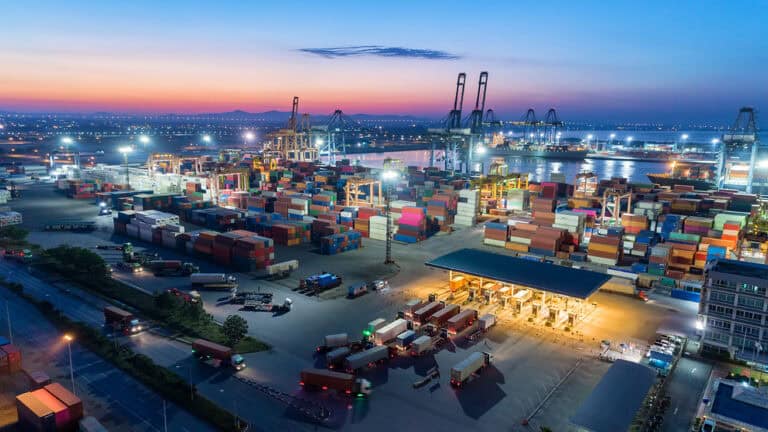Contributed by Nicole Leinbach Reyhle, Founder of Retail Minded
Achieving a connected supply chain has proven itself a challenge time and time again, particularly as our global economy continues to recover from the pandemic. Keeping this in mind, the National Retail Federation’s recent, debut 360 Supply Chain event was a welcomed experience that delivered valuable insight and solutions for industry decision makers looking to optimize their supply chain efforts. I was honored to be among those who attended as part of an e2open panel, joined by e2open’s Jenny Roman, Director of Solutions Consulting. Additionally, industry leaders Jordan Speer, a Research Manager for IDC Retail Insights, and Rebecca Monash, who is the Director or Operations for athletic merchant P.Volve joined us as we collectively delivered a panel discussion about connected supply chain. Additionally, e2open hosted a central booth on the NRF 360 Supply Chain exhibit floor where it caught up with existing e2open customers, such as Trek Bicycles, and many other retail attendees.
Mike Hitmar, Director of Industry Product Marketing for e2open, shares that “NRF 360 is the event the industry needs. It is a testimony to how supply chain has become a board room topic; it was great to talk to decision makers as they search for technology that will help them achieve next-level supply-chain maturity and future-proof their businesses for the challenges and opportunities ahead.”
Roman shared this sentiment, noting as part of a panel discussion at the event that technology is the great enabler.
“It is important that retailers consider their supply chain when dealing with disruptions, including everything from upstream planning to downstream execution. The days of working with siloed systems and disconnected trading partners is no longer good enough,” she said. “Retailers need a single platform that [provides] visibility and brings in all the data needed to make quick, proactive informed decisions or face the risk of lower service levels, greater risk factors, and, ultimately, brand damage.”
Eliminating siloed supply chains is fortunately a possibility that merchants of all sizes can accomplish if they proactively introduce technology that enables it. NRF 360 brought to its show floor the vast range of technology solutions available to help connect supply chains. More specifically, e2open is proud to be among the solutions helping to connect the many tiers, functions, and ecosystems of global supply, logistics, and trading.
Speer, who joined e2open’s Roman on a panel discussion about the connected supply chain, discussed several of the benefits of eliminating siloes, sustainability among them. “Thinking about connecting and optimizing supply chains opens a great opportunity to think about building a more sustainable supply chain, because these two things go hand in hand. Consider that when you are optimizing, you are looking across an entire entity to make best use of all parts, rather than maximizing for one node,” she said “The further back you can pull your lens to encompass as many operations as possible, the better the whole organism can function, and the more waste and inefficiency can be removed. Achieving this requires integration across the supply chain, including between planning and execution, so that each has visibility into real-time relevant data from the other and decisions can be made that optimize the functioning of the entire end-to-end product journey. This cannot be accomplished when supply chains are disconnected and data is siloed,” she said.
With sustainability a hot – and important – discussion topic at NRF 360, one takeaway remained evident no matter what the core topic of interest was: retailers must be realistic with their planning, taking into account in their decision making that many products may be delayed. Addressing the challenge of supply chain disruption must include strategic, honest and proactive conversations between retailers and their vendors, while also leveraging technology to bring clarity to the realities of supply disruption.
As Speer states, “There are great risks in not diversifying inventory, suppliers, and supply chain efforts. In IDC’s recent supply chain survey, diversifying globally was the top response among retailers ( 23+%) — particularly apparel retailers (42.1%) – when we asked what steps they were taking to mitigate risk,” she said. “There is a different set of risks that expands as a company diversifies, which is that the complexity continues to intensify, and visibility is increasingly occluded, and so it makes sense that the second step is improving supply chain visibility (22.7%).
“Greater diversification means more farms, mills, factories, suppliers, and so forth to track and trace, to audit, to ensure are compliant and to move product from. There are different trade agreements, government regulations, languages, cultures, payment systems, taxes. New transportation and logistics networks. The complexities are enormous. A connected platform on which everyone can see one version of the ’truth’ and be able to make decisions in real time or near real time is critical especially with the added volatility coming from shifts in consumer behavior as well as supply chain constraints,” said Speer.
“This – a connected platform — gets us closer to the ideal of planning and execution working in tandem to optimize decision making. Imagine, for example, if an apparel top and bottom are being made in different factories in different countries of different types of fabrics whose color is ultimately supposed to match, and there are problems with the fabric mill for the pants. Now you’ve got a large order of blouses that don’t have pants to match. If you know that very early on, you’ll plan a different assortment. If you find that out as it happens, you can pivot to another type of matching garment that can be made elsewhere. None of that can happen without visibility across a connected ecosystem,” she said.
Finally, as we look ahead into the third and fourth quarter of 2022, e2open’s Hitmar offers this piece of advice.
“Take a deep breath. The second half of 2022 is not looking any rosier than it was the last two years. In today’s complex supply chains and turbulent market conditions, retailers need to understand what is happening as far upstream and downstream as possible,” he said. “Only then they can have reaction time to deal with disruptions big and small. To do this, they need data — multi-enterprise, multi-tier data — that is cleansed, harmonized and analyzed to find insights, early warnings, and recommended actions. This is exactly what the e2open platform does for the world’s leading supply chains.”







